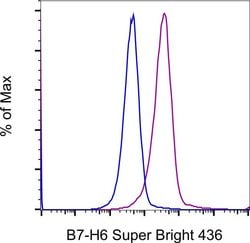Learn More
Invitrogen™ B7-H6 Monoclonal Antibody (JAM1EW), Super Bright™ 436, eBioscience™
Mouse Monoclonal Antibody
Supplier: Invitrogen™ 62652642

Description
This JAM1EW monoclonal antibody recognizes human B7-H6 (NCR3LG1) protein on the surface of cells. It recognizes protein on live but not on paraformaldehyde-fixed cells. The JAM1EW clone is specific to B7-H6. When tested in flow cytometry against cells transfected with either B7-H4, B7-H5, B7-H6, or B7-H7, clone JAM1EW only stains positively on B7-H6 transfected cells. Applications Reported: This JAM1EW antibody has been reported for use in flow cytometric analysis. Applications Tested: This JAM1EW antibody has been pre-diluted and tested by flow cytometric analysis of the HL-60 cell line. This may be used at 5 μL (1 μg) per test. A test is defined as the amount (μg) of antibody that will stain a cell sample in a final volume of 100 μL. Cell number should be determined empirically but can range from 10^5 to 10^8 cells/test. Super Bright 436 can be excited with the violet laser line (405 nm) and emits at 436 nm. We recommend using a 450/50 bandpass filter, or equivalent. Please make sure that your instrument is capable of detecting this fluorochrome. When using two or more Super Bright dye-conjugated antibodies in a staining panel, it is recommended to use Super Bright Complete Staining Buffer (Product # SB-4401) to minimize any non-specific polymer interactions. Please refer to the datasheet for Super Bright Staining Buffer for more information. Excitation: 405 nm; Emission: 436 nm; Laser: Violet Laser Super Bright Polymer Dyes are sold under license from Becton...
B7-H6 (NCR3LG1) is a transmembrane endogenous ligand expressed on the surfaces of tumor cells. B7-H6 binds with NKp30 present on NK cells. Binding of B7-H6 to NKp30 causes the ligation of NKp30 subsequently inducing NK cell activation and target cell cytolysis. B7-H6 is not constitutively expressed on normal tissue. Whether it can be expressed endogenously under certain conditions is under investigation. B7-H6 has been detected on circulating pro-inflammatory CD14(+)CD16(+) monocytes in some patients with sepsis.
Specifications
| B7-H6 | |
| Monoclonal | |
| 5 μL/Test | |
| PBS with BSA and 0.09% sodium azide; pH 7.2 | |
| Q68D85 | |
| NCR3LG1 | |
| B7-H6 recombinant protein. | |
| 100 Tests | |
| Primary | |
| Human | |
| Antibody | |
| IgG1 κ |
| Flow Cytometry | |
| JAM1EW | |
| Super Bright 436 | |
| NCR3LG1 | |
| B7 homolog 6; B7H6; B7-H6; DKFZp686I21167; DKFZp686O24166; natural cytotoxicity triggering receptor 3 ligand 1; natural killer cell cytotoxicity receptor 3 ligand 1; NCR3LG1; putative Ig-like domain-containing protein DKFZp686O24166/DKFZp686I21167 | |
| Mouse | |
| Affinity Chromatography | |
| RUO | |
| 374383 | |
| 4°C, store in dark, DO NOT FREEZE! | |
| Liquid |
The Fisher Scientific Encompass Program offers items which are not part of our distribution portfolio. These products typically do not have pictures or detailed descriptions. However, we are committed to improving your shopping experience. Please use the form below to provide feedback related to the content on this product.
